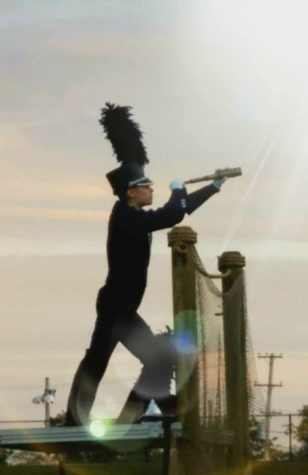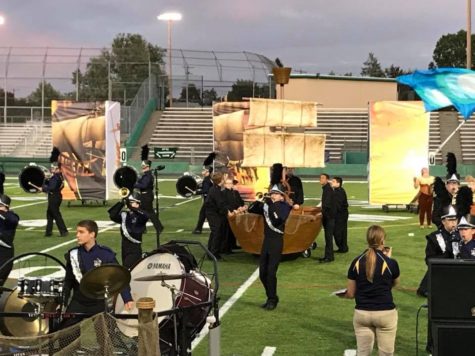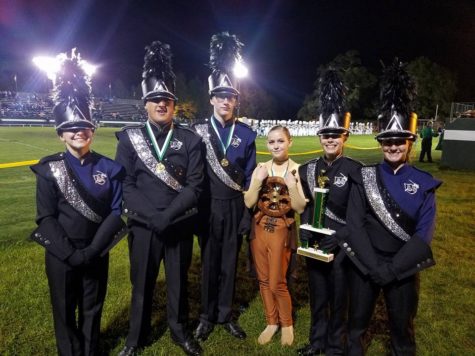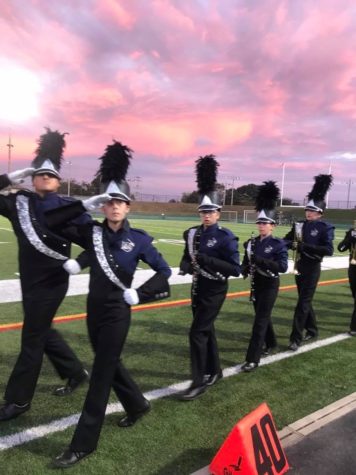The SBRHS Band Starts of the Season in Smooth Waters
October 23, 2017
The Somerset Berkley Regional High School Band has had a lot of success in their season thus far. The band competes in two circuits as Mr. Marshall explains: “On the national level in USBands, we are a Division 1A Band and in the regional level in NESBA (New England Scholastic Band Association), we are a Division II Band.”
They have had one competition in NESBA and three in USBands, all of which they have come in first and won all the caption awards in their division. This includes Best Music, Best Color Guard, and Best Percussion for NESBA Caption Awards and Best Music, Best Visual Effect, and Best Effect Overall for USBands Caption Awards. They also have recently performed at home and for the Musictown Kiddie’s Day.
The judging in both these circuits are both different and similar in that there are often two music judges, one visual judge, and one overall effect judge. One music judge observes from the press box and the other is right on the field. This judge is marking the “individual and sectional success of the various musical sections of the band” while the other judge “adjudicates the musical performance of the  entire ensemble as a whole,” says Mr. Marshall. The visual judge is responsible for the marching technique, drill formations, and Color Guard performance. Lastly, the overall effect judge is in charge of determining the overall effect of the musical, visual, and artistic components of the performance and how they work together. The scores are presented in a 0-100 scale and are out of 100% with rubrics given to students in staff on the individual categories. Mr. Marshall adds that this was “both a way to compare bands and rank them, but it is a educational experience as well.”
entire ensemble as a whole,” says Mr. Marshall. The visual judge is responsible for the marching technique, drill formations, and Color Guard performance. Lastly, the overall effect judge is in charge of determining the overall effect of the musical, visual, and artistic components of the performance and how they work together. The scores are presented in a 0-100 scale and are out of 100% with rubrics given to students in staff on the individual categories. Mr. Marshall adds that this was “both a way to compare bands and rank them, but it is a educational experience as well.”
The band performed their rigorously practiced performance, “The Voyage.” Jill Platt  a tenor saxophone in the horn line describes that “the music centers around setting sail on an adventure and on the Voyage we have to overcome a storm.” Jonathan Cabral, Electric Guitar player in the pit band, added that “it starts off calm, but the show brings you throw the storm, its eye, and then out of the storm.” Mr. Marshall arranged the music with percussion instructors Brandon Carrita and David Mills to tell a story of 15th century sea exploration with sections from “Into the Raging River” by Steven Reineke, “Loch Lomond,” a Traditional Scottish Song associated with sea voyages, “Into the Storm” by Robert W. Smith, “Eternal Father, Strong to Save” by William Whiting, and “Ghost Fleet” by Robert Sheldon. Mr. Marshall explains that these pieces are not supposed to be recognizable for the purpose of keeping the audience engaged in the “moods and motifs” of the piece itself and the story that it tells. Therefore, the music is “programmatic and sound like movie soundtracks,” Mr. Marshall says.
a tenor saxophone in the horn line describes that “the music centers around setting sail on an adventure and on the Voyage we have to overcome a storm.” Jonathan Cabral, Electric Guitar player in the pit band, added that “it starts off calm, but the show brings you throw the storm, its eye, and then out of the storm.” Mr. Marshall arranged the music with percussion instructors Brandon Carrita and David Mills to tell a story of 15th century sea exploration with sections from “Into the Raging River” by Steven Reineke, “Loch Lomond,” a Traditional Scottish Song associated with sea voyages, “Into the Storm” by Robert W. Smith, “Eternal Father, Strong to Save” by William Whiting, and “Ghost Fleet” by Robert Sheldon. Mr. Marshall explains that these pieces are not supposed to be recognizable for the purpose of keeping the audience engaged in the “moods and motifs” of the piece itself and the story that it tells. Therefore, the music is “programmatic and sound like movie soundtracks,” Mr. Marshall says.
There are four sections of the piece, “Setting Sail on a New Adventure,” “The Storm,” “The Eye of the Storm,” and “Surviving the Storm / The Journey Home.” Each section has its own backdrop and features their ship, The Blue Raider. The first part depicts preparation for the journey and “setting out on the adventure with great excitement and optimism,” Mr. Marshall says. The second part shows the ship confronted by an on coming storm as the backdrop of a morning sky disappears and the mood becomes darker. Mr. Marshall describes that the “music is much more aggressive and features the percussion section while the horn line and color guard are found racing around the boat  in jeopardy.” In ” The Eye Of the Storm,” the clouds part and the music slows down with a “beautiful hymn that is associated with prayers for sailors to have safe journey and an unharmed return home,” Mr. Marshall says. To the sailors’ dismay the storm returns with aggressive music and more complex drill maneuvers that depict the “roughest part of the storm.” This is the third part, the ship has returned home, though beat up, and the crew is victorious.
in jeopardy.” In ” The Eye Of the Storm,” the clouds part and the music slows down with a “beautiful hymn that is associated with prayers for sailors to have safe journey and an unharmed return home,” Mr. Marshall says. To the sailors’ dismay the storm returns with aggressive music and more complex drill maneuvers that depict the “roughest part of the storm.” This is the third part, the ship has returned home, though beat up, and the crew is victorious.
For my final question when I interviewed Mr. Marshall, I asked him if there are things that are going great or that could be improved upon. He  explained that, “my philosophy in both writing and teaching a show is that we need to have a visual and musical product that is challenging enough for our students to be able to continuously improve upon throughout the season and achievable enough for our technical prowess to be able perform the show with a high level of success. It’s a delicate balance, but it is working out well,” Mr. Marshall says. He added that, of course, there are things to be improved upon. His motto in successfully performing is “never accept your present level of achievement” and “amateurs practice until they get it right, professionals practice until they can’t get it wrong.” Mr. Marshall also mentions that his performers have “had great respect for the process.” So far, it has been “an exciting season and I predict this voyage will lead these students to great success!” Mr. Marshall says.
explained that, “my philosophy in both writing and teaching a show is that we need to have a visual and musical product that is challenging enough for our students to be able to continuously improve upon throughout the season and achievable enough for our technical prowess to be able perform the show with a high level of success. It’s a delicate balance, but it is working out well,” Mr. Marshall says. He added that, of course, there are things to be improved upon. His motto in successfully performing is “never accept your present level of achievement” and “amateurs practice until they get it right, professionals practice until they can’t get it wrong.” Mr. Marshall also mentions that his performers have “had great respect for the process.” So far, it has been “an exciting season and I predict this voyage will lead these students to great success!” Mr. Marshall says.

